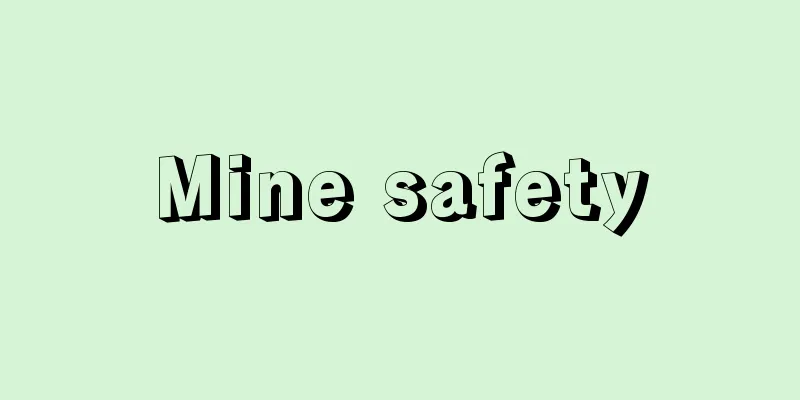Mine safety

|
Mine workers should not be killed or injured or suffer from occupational diseases as a result of their work. When the accident rate at a mine is low, the safety of that mine is ensured. According to the Mine Safety Law (Law No. 70 of 1949), "safety" refers to the following matters related to mining: (1) prevention of harm to people in mines, (2) protection of mineral resources, (3) preservation of mine facilities, and (4) prevention of mining damage. Prevention of harm to people in mines is also said to include ventilation for sanitation and rescue in the event of a disaster. Maintaining and improving mine safety requires research and development of safety technologies suited to the actual conditions of mines and their appropriate application in practice, as well as the establishment and operation of functional safety management organizations at the national and mine levels. Mining rights holders (corporations or individuals with the right to dig and acquire minerals within a certain registered mining area = mine operators) must take measures to ensure mine safety, including: (1) prevention of cave-ins, collapses, flooding, gas outbursts, gas or coal dust explosions, spontaneous combustion, and mine fires, (2) prevention of hazards or mine damage associated with the disposal of gas, dust, rubble, slag, mine water, wastewater, and mine smoke, (3) prevention of hazards associated with the handling of machinery, tools, explosives, other materials, power, and fire, (4) ensuring ventilation and setting up rescue organizations, (5) protection of mineral resources, (6) maintenance of machinery, tools, buildings, and structures, and (7) prevention of mine damage caused by excavation and other safety measures. Mine employees must properly observe the necessary safety measures in the mine. [Nobuo Fusamura] Mine Safety Management OrganizationIn order to ensure safety at the mine, the mining right holder must appoint appropriate personnel and establish a mine safety management organization in accordance with the provisions of the Mine Safety Law. This organization is composed of a safety manager who supervises the implementation of mining activities at the mine, a safety technical manager and a deputy safety manager who assist him in managing technical matters related to mine safety, safety officers who are in charge of safety matters in their specialized fields under the direction of these senior officials, safety supervisors who have the authority to advise the manager or officers to suspend use of the facility, repair, remodel, or relocate it, or to improve the method of implementing mining activities, and other necessary matters for safety when necessary, and safety supervisor assistants recommended by the mine workers to assist them. In addition, safety officers are classified according to their duties, such as outside mine safety, inside mine safety, machine safety, electrical safety, steam boilers, explosives, blasting, welding, mine pollution prevention, and mine safety (oil mines). [Nobuo Fusamura] Mine Safety TechnicianSince mine safety is a technology related to protecting human life in mines, technical staff who work on the work must have sufficient knowledge and skills in mine safety and meet certain qualifications. Therefore, it is stipulated that mining rights holders must select the necessary safety technical staff from among those who have passed the national examination for safety technical staff conducted by the government. The national examination consists of advanced examinations for safety technical managers, safety supervisors, etc., and ordinary examinations for safety officers according to each division of responsibilities, and is administered by the Central Mine Safety Council (formerly the Mine Safety Examination Board) established in the Ministry of Economy, Trade and Industry. Safety technical staff are classified into Class A for Class A coal mines, Class B for Class B coal mines and other general mines, Class C for oil and natural gas mines, and Class D for nuclear raw material mines. [Nobuo Fusamura] Mine Safety CenterIn order to promote the dissemination and improvement of knowledge and skills concerning mine safety among mine safety technical personnel and mine workers, the government built mine safety centers in Iwamizawa City, Hokkaido and Kasuya Town, Fukuoka Prefecture in 1968 (Showa 43), and these are managed by the Mine Workers' Accident Prevention Association. These centers have training tunnels and other educational and training facilities, and with government funding, they regularly train mine rescue team members, educate safety technical personnel, provide education and training in blasting techniques and other specialized skills, and hold research meetings on safety management techniques. They also provide rescue training for city fire department personnel. [Nobuo Fusamura] [Reference] | |Source: Shogakukan Encyclopedia Nipponica About Encyclopedia Nipponica Information | Legend |
|
鉱山労働者が鉱山作業によって死傷したり職業病にかかったりしないこと。鉱山における災害率が低いとき、その鉱山の保安が確保されているという。鉱山保安法(昭和24年法律70号)によれば、「保安」とは鉱業に関する次の事項をいうとされている。(1)鉱山における人に対する危害の防止、(2)鉱物資源の保護、(3)鉱山の施設の保全、(4)鉱害の防止。なお、鉱山における人に対する危害の防止には、衛生に関する通気および災害時における救護を含むものとされている。 鉱山保安の維持・向上には、鉱山の実態に即した保安技術の研究開発と実務への適切な応用、ならびに国および鉱山における機能的な保安管理機構の確立と運営が必要である。 鉱業権者(登録を受けた一定の鉱区内で鉱物を掘採し取得する権利を有する法人または個人=鉱山経営者)が鉱山保安確保のために講じなければならない問題には次のようなものがある。(1)落盤、崩壊、出水、ガスの突出、ガスまたは炭塵(たんじん)の爆発、自然発火および坑内火災の防止、(2)ガス、粉塵、捨石、鉱滓(こうさい)、坑水、廃水および鉱煙の処理に伴う危害または鉱害の防止、(3)機械、器具または火薬類その他の材料、動力および火気の取扱いに伴う危害の防止、(4)通気の確保および救護組織の設置、(5)鉱物資源の保護、(6)機械、器具、建設物および工作物の保全、(7)土地の掘削による鉱害の防止その他の保安。鉱山の従業員は鉱山において保安のため必要事項を正しく守らなければならない。 [房村信雄] 鉱山保安管理機構鉱業権者は鉱山における保安を確保するため、鉱山保安法規の規定により、適切な人員を選任して鉱山保安管理機構を確立しなければならない。この機構は、当該鉱山において鉱業の実施を統括管理する保安統括者、これを補佐して鉱山保安に関する技術的事項を管理する保安技術管理者および副保安管理者、これら上級職員の指揮を受けて専門分野の保安に関する事項を分掌する保安係員、保安確保のため必要があるときは管理者または係員に対しその施設の使用の停止・修理・改造もしくは移転または鉱業の実施の方法の改善その他保安のため必要事項を勧告する権限を有する保安監督員、およびこれを補佐するためその鉱山の鉱山労働者のうちから推薦された保安監督員補佐員からなる。なお、保安係員には分掌事項によって、坑外保安、坑内保安、機械保安、電気保安、汽かん、火薬、発破、溶接、鉱害防止、鉱場保安(石油鉱山)などの別がある。 [房村信雄] 鉱山保安技術職員鉱山保安は鉱山における人命保護に関する技術であるから、その実務にあたる技術職員は鉱山保安に関して十分な知識と技術をもち、一定の資格条件を満たす者でなければならない。そこで鉱業権者は、国の行う保安技術職員国家試験に合格した者のうちから必要な保安技術職員を選任するように定められている。国家試験は保安技術管理者、保安監督員等に対する上級試験と、各分掌事項に応じた保安係員に対する普通試験の別があり、経済産業省に設置された中央鉱山保安協議会(旧鉱山保安試験審査会)が行う。なお、保安技術職員には甲種炭坑に対する甲種、乙種炭坑その他の一般鉱山に対する乙種、石油・天然ガス鉱山に対する丙種、核原料物質鉱山に対する丁種の別がある。 [房村信雄] 鉱山保安センター鉱山保安技術職員および鉱山労働者の鉱山保安に関する知識と技術の普及・向上を図るため、国は1968年(昭和43)に北海道岩見沢市と福岡県粕屋(かすや)町に鉱山保安センターを建設し、鉱業労働災害防止協会が管理にあたっている。ここでは、訓練坑道その他の教育訓練設備を有し、国の資金援助のもとに鉱山救護隊員の養成、保安技術職員の教育、発破技術その他の専門技術の教育訓練、保安管理技術の研究集会などが定期的に行われている。ここではまた、都市消防署員の救護訓練も行われている。 [房村信雄] [参照項目] | |出典 小学館 日本大百科全書(ニッポニカ)日本大百科全書(ニッポニカ)について 情報 | 凡例 |
Recommend
Umenomiya Taisha Shrine
It is located in Umezu Fukenogawacho, Ukyo Ward, ...
Energy efficiency
Formerly known as caloric efficiency, it is an ind...
Foreign Currency - Gaikadate
The buying and selling of financial products and i...
Liang Ji (English spelling)
[raw]? [Died] Enki 2 (159).8.10. A relative of the...
Educational welfare work staff training institute
...Reformatory schools are the successors of refo...
Multiplication operator
...The simplest of these is the differential oper...
Contempt of Congress
…In the UK, the House of Commons (lower house), a...
Gas (English spelling)
A common name for flammable or toxic gases such as...
Jorge Basadre
1903‐80 Peruvian historian. Born in Tacna under Ch...
Iki Riki
…The Kikitsu area has seen a remarkable influx of...
Majorite
...The results of these high-pressure experiments...
Kitakami Canal
This canal connects Takayashiki, Hebita, Ishinoma...
Inano Omura Tomb - Inano Omura Tomb
…There are cases where the cremation site is used...
CAI - C-A-I
Education based on the idea of individualized l...
Spectrum - spectrum (English spelling)
A band of light images arranged in the order of w...





![Sakurajima [town] - Sakurajima](/upload/images/67cba9a56cff6.webp)



